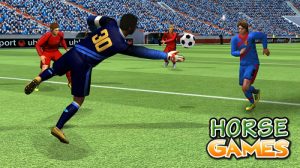
In the competitive world of online shooter games, mastering your aim is crucial for success. Whether you’re a seasoned veteran or a new recruit, there’s always room for improvement. This guide delves into the intricacies of aim mechanics, effective training techniques, in-game strategies, and hardware considerations to help you elevate your skills and dominate the battlefield.
From understanding the nuances of sensitivity and DPI to implementing targeted practice routines and analyzing your gameplay, we’ll explore a comprehensive approach to sharpening your aim. We’ll also touch upon the importance of mental focus, staying calm under pressure, and utilizing the right equipment to optimize your performance.
Understanding Aim Mechanics

Before diving into specific techniques, it’s crucial to grasp the fundamental mechanics that influence your aim in online shooter games. These mechanics directly impact how your mouse movements translate into in-game actions, affecting your accuracy and speed.
Sensitivity and DPI
Sensitivity and DPI are two key factors that determine how your mouse movements translate into in-game cursor movements.
- Sensitivity refers to the in-game setting that controls how much your cursor moves on the screen for a given distance of mouse movement. A higher sensitivity means your cursor will move faster across the screen, while a lower sensitivity results in slower movement.
- DPI (Dots Per Inch) refers to the physical sensitivity of your mouse. It determines how many dots the mouse sensor registers for every inch of movement. A higher DPI mouse will be more sensitive to movement, registering more dots per inch.
While both sensitivity and DPI contribute to your aim, they are distinct concepts. DPI affects the mouse’s physical sensitivity, while sensitivity is a game setting that scales your mouse movement within the game.
The Importance of Finding the Right Sensitivity
Finding the right sensitivity for your playstyle is essential for achieving consistent accuracy and responsiveness. A sensitivity that is too high can lead to overshooting targets, while a sensitivity that is too low can make it difficult to track fast-moving enemies.
- High Sensitivity: Players who prefer a high sensitivity often find it easier to track targets quickly and make rapid adjustments. However, it can be challenging to maintain precision and control, especially at longer ranges.
- Low Sensitivity: Players who prefer a low sensitivity prioritize precision and control, particularly for long-range shots. However, it can make it harder to track targets quickly and may require more arm movement.
The ideal sensitivity is a balance between speed and accuracy. Experiment with different settings to find a sensitivity that allows you to track targets effectively while maintaining precision.
Impact of DPI on Aim Accuracy and Speed
DPI directly impacts the responsiveness of your mouse. A higher DPI mouse will be more sensitive to movement, making it easier to make small, precise adjustments. However, a higher DPI can also make it more difficult to control your mouse movement, especially if you have a large mousepad.
- High DPI: A high DPI mouse can be beneficial for players who prefer quick, precise adjustments. However, it can be challenging to control the mouse, especially at higher sensitivities.
- Low DPI: A low DPI mouse can be more stable and easier to control, particularly at lower sensitivities. However, it may require more arm movement to make significant adjustments.
The ideal DPI for you will depend on your mouse sensitivity, playstyle, and mousepad size.
Common Settings that Affect Aim in Various Shooter Games
Various settings within shooter games directly influence your aim. Understanding these settings and how they affect your gameplay can help you optimize your aim for maximum performance.
- Field of View (FOV): FOV determines how much of the game world you can see at once. A higher FOV provides a wider view, making it easier to spot enemies, but can also make it harder to focus on individual targets. A lower FOV provides a narrower view, which can help you focus on individual targets but can make it harder to see enemies at the edges of your screen.
- Mouse Acceleration: Mouse acceleration affects how quickly your cursor moves based on the speed of your mouse movement. It can be helpful for making quick adjustments, but it can also make it difficult to maintain consistency and accuracy. Many players prefer to disable mouse acceleration for a more linear and predictable response.
- Aim Assist: Aim assist is a feature found in many shooter games that automatically helps you aim at enemies. It can be helpful for players who are new to the game or who have difficulty aiming. However, it can also be a crutch that hinders your ability to improve your aim independently.
- Crosshair: Your crosshair is the visual indicator that represents your aim. Choosing the right crosshair for your playstyle can significantly impact your accuracy and ability to track targets. Experiment with different crosshair styles and colors to find one that works best for you.
Analyzing Gameplay

Analyzing your gameplay is crucial for identifying areas for improvement and optimizing your aim. By reviewing your performance, you can gain valuable insights into your strengths, weaknesses, and areas that require further development. This process involves actively watching your gameplay, identifying patterns, and understanding the underlying mechanics of your actions.
Reviewing Gameplay Footage
Reviewing your gameplay footage is an effective way to identify areas for improvement. By watching your past matches, you can objectively assess your aim, movement, decision-making, and overall strategy. This process helps you pinpoint specific areas that require attention.
- Record Your Gameplay: Use a recording software or your console’s built-in recording feature to capture your matches. This allows you to revisit your performance and analyze your actions.
- Focus on Specific Goals: When reviewing your gameplay, focus on specific aspects you want to improve, such as tracking, flick shots, or recoil control.
- Identify Patterns: Pay attention to recurring patterns in your gameplay. Are you consistently missing shots at a certain range? Do you struggle with tracking moving targets?
- Analyze Your Decision-Making: Examine your positioning, engagements, and overall strategy. Did you make the right decisions in certain situations? Could you have played differently?
Understanding Strengths and Weaknesses
Understanding your strengths and weaknesses is fundamental to improving your aim. By identifying your areas of expertise and areas that require improvement, you can focus your practice and development efforts more effectively.
- Identify Your Strengths: What aspects of your gameplay do you excel at? Are you good at tracking, flick shots, or recoil control?
- Acknowledge Your Weaknesses: Be honest with yourself about your weaknesses. Are you struggling with certain ranges, specific types of targets, or particular weapon types?
- Focus on Improvement: Once you understand your strengths and weaknesses, prioritize practicing and developing the areas that need improvement.
Using Replays and Demos
Replays and demos provide a valuable tool for analyzing your aim performance. They allow you to review specific moments in detail, study your movements, and understand the mechanics of your actions.
- Utilize Replay Features: Most online shooters offer replay features that allow you to rewatch your matches from different perspectives.
- Slow Down the Action: Slow down the replay to analyze your movements and aim in detail. This helps you identify subtle errors and inconsistencies.
- Examine Crosshair Placement: Pay attention to your crosshair placement, especially during engagements. Did you anticipate the target’s movement correctly?
- Analyze Your Mouse Movements: Observe your mouse movements during tracking and flick shots. Are your movements smooth and controlled?
Seeking Feedback from Experienced Players
Seeking feedback from experienced players can provide valuable insights into your gameplay and aim performance. They can offer constructive criticism, identify areas for improvement, and share their knowledge and expertise.
- Join Communities: Engage with online communities and forums related to your game. Seek out experienced players and ask for feedback on your gameplay.
- Find a Coach: Consider hiring a coach who can provide personalized feedback and guidance. They can help you identify and address specific areas for improvement.
- Be Open to Criticism: Be receptive to feedback, even if it’s negative. Use it as an opportunity to learn and grow.
By understanding the fundamentals of aim, dedicating time to practice, and implementing strategic approaches, you can unlock your true potential in online shooter games. Remember, consistency is key. Continuously refine your techniques, analyze your performance, and seek feedback from experienced players to achieve lasting improvement. The journey to becoming a skilled shooter is an ongoing process, and with dedication and the right tools, you can conquer any challenge that comes your way.
Query Resolution
What is the best sensitivity setting for online shooter games?
There is no one-size-fits-all answer, as the optimal sensitivity depends on individual playstyle and preferences. Experiment with different settings in training maps or custom practice routines to find what feels comfortable and allows you to track targets accurately.
How often should I practice my aim?
Regular practice is essential for improvement. Aim for at least 30 minutes to an hour of dedicated aim training per day, focusing on specific aspects like tracking, flicking, and precision.
What are some good aim trainers to use?
Popular aim trainers include Kovaak’s FPS Aim Trainer, Aim Lab, and Aim Hero. These platforms offer various exercises and challenges to help you develop your aiming skills.




